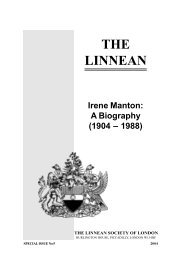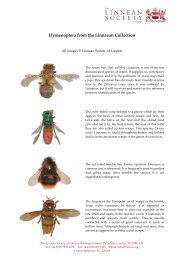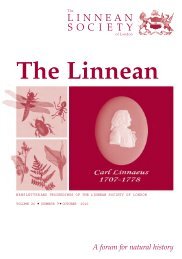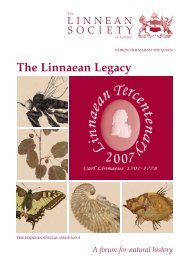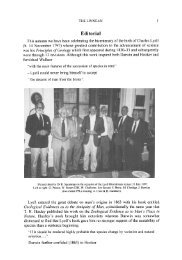Vol 25, no 3, October - The Linnean Society of London
Vol 25, no 3, October - The Linnean Society of London
Vol 25, no 3, October - The Linnean Society of London
You also want an ePaper? Increase the reach of your titles
YUMPU automatically turns print PDFs into web optimized ePapers that Google loves.
16<br />
THE LINNEAN 2009 VOLUME <strong>25</strong>(3)<br />
might be so called with equal propriety. <strong>The</strong> inhabitants living chiefly upon shellfish,<br />
are obliged constantly to change their place <strong>of</strong> residence; but they return at intervals to<br />
the same spots, as is evident from the pile <strong>of</strong> old shells, which must <strong>of</strong>ten amount to<br />
some tons in weight. <strong>The</strong>se heaps can be distinguished at a long distance by the green<br />
colour <strong>of</strong> certain plants, which invariably grow on them. Among these may be enumerated<br />
the wild celery and scurvy grass, two very serviceable plants, the use <strong>of</strong> which has <strong>no</strong>t<br />
been discovered by the natives.<br />
“<strong>The</strong> Fuegian wigwam resembles, in size and dimensions, a haycock. It merely consists<br />
<strong>of</strong> a few broken branches stuck in the ground, and very imperfectly thatched on one side<br />
with a few tufts <strong>of</strong> grass and rushes. <strong>The</strong> whole can<strong>no</strong>t be so much as the work <strong>of</strong> an<br />
hour, and it is only used for a few days. At Goeree Roads I saw a place where one <strong>of</strong><br />
these naked men had slept, which absolutely <strong>of</strong>fered <strong>no</strong> more cover than the form <strong>of</strong> a<br />
hare. <strong>The</strong> man was evidently living by himself, and York Minster said he was ‘very bad<br />
man’, and that probably he had stolen something. On the west coast, however, the<br />
wigwams are rather better, for they are covered with seal-skins.”<br />
Darwin provides a good description here <strong>of</strong> the Yámana mode <strong>of</strong> life. It is strange<br />
though, that the ‘wigwam’ he observed is described as ‘merely consisting <strong>of</strong> a few<br />
broken branches’, and as ‘very imperfectly thatched’. No doubt these houses sufficed;<br />
they would have represented a bad adaptation to a hard environment if more labourtime<br />
than was necessary were expended on their construction. In a case like this, a<br />
direct comparison might reasonably and legitimately be made between adaptations to<br />
the environment developed by human beings on the one hand and by other animals on<br />
the other.<br />
<strong>The</strong>se people were <strong>no</strong>madic hunter-gatherers, spending ‘only a few days’ in any<br />
particular ‘wigwam’; if ‘on the west coast the wigwams are rather better, for they are<br />
covered with seal-skins’, presumably this is either because seals are more available<br />
on the west coast than at Kater’s Peak, or because the weather on the west coast is that<br />
much more inclement, making it worthwhile or necessary to undertake the effort <strong>of</strong><br />
protecting homes with seal-skins.<br />
It is unreasonable perhaps to dispute the validity <strong>of</strong> Darwin’s observations <strong>of</strong><br />
Yámana houses. Nevertheless, when one looks at the replicas <strong>of</strong> typical Yámana houses<br />
outside the Museo Del Fin Del Mundo in Ushuaia, or at old photographs <strong>of</strong> real ones,<br />
one can only say that they appear extremely well-built, sturdy, functional, and attractive.<br />
Just as the bows and arrows, harpoons, baskets and other utensils on display in the<br />
museums at Ushuaia are very beautifully made; exemplary instances <strong>of</strong> objects made<br />
both for use and in accordance with aesthetic principles, as William Morris believed<br />
is true <strong>of</strong> all authentic art and craft.<br />
<strong>The</strong> comment made by York Minster that Darwin records, indicates that the former’s<br />
English acculturation has turned him into something <strong>of</strong> a s<strong>no</strong>b, as well as encouraging<br />
him apparently to accuse a man <strong>of</strong> a crime without evidence or pro<strong>of</strong>.<br />
It is striking that amidst the close and accurate account that Darwin gives <strong>of</strong> the<br />
Yámana lifestyle, he describes their evidently effective solution to the challenges <strong>of</strong><br />
their environment as obliging them ‘constantly to change their place <strong>of</strong> residence’.<br />
This mode <strong>of</strong> expressing it implies it is undesirable and ab<strong>no</strong>rmal so to live; to stay in<br />
one place indefinitely is desirable and <strong>no</strong>rmal. Is it <strong>no</strong>t odd that Charles Darwin, the



